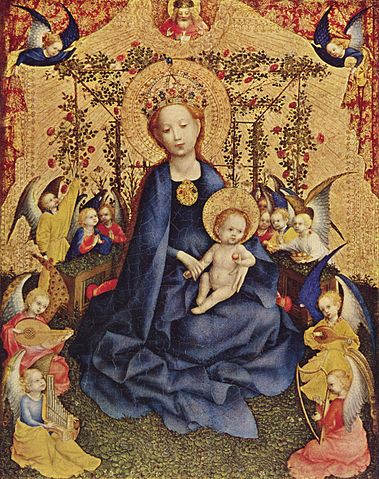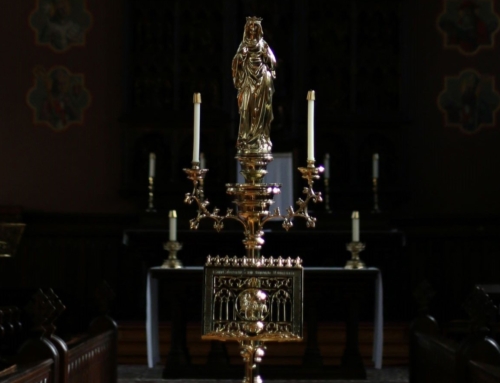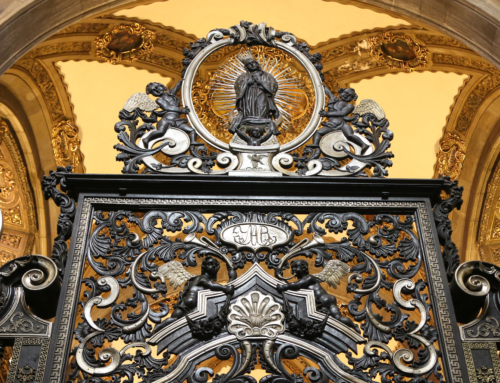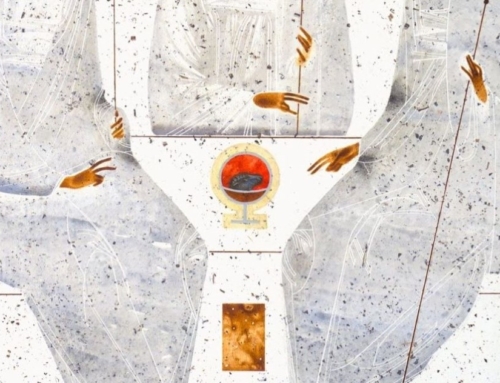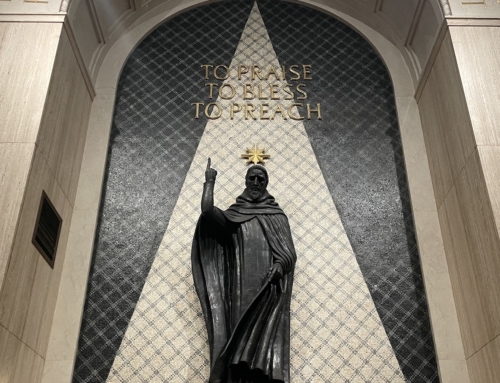Aidan Nichols, There is No Rose: Mariology of the Catholic Church. Minneapolis: Fortress, 2015.
There is no rose of such virtue/ As is the Rose that bare Jesu
It is from these verses that Fr. Aidan Nichols, O.P., takes the name of his new book There Is No Rose: The Mariology of the Catholic Church. The book, he tells us, aims “to contribute to the revival of a more full-blooded body of Marian teaching,” following especially the very Marian pontificate of Pope St. John Paul II (x). The context of the book is Mariology following the twentieth-century ressourcement movement and the dogmatic treatment of the Blessed Virgin Mary as a type of the Church in the Second Vatican Council’s dogmatic constitution on the Church, Lumen Gentium.
Attempting to write a theological account of Mary today involves standing at the intersection of several strong currents: questions of theological method (including the ressourcement emphasis on Scriptural exegesis and return to Patristic sources), ecumenical studies, liturgical studies, pious devotion, and debates about the interpretation of the Second Vatican Council. Aidan Nichols is well situated to articulate an overview of Mariology given his extensive treatment of many of these subjects in his book The Shape of Catholic Theology, his knowledge of and sympathy with la nouvelle theologie, his treatment of Reginald Garrigou-Lagrange in Reason with Piety, and his general commitment to doing Catholic theology within a “hermeneutic of continuity,” which in this case requires a synthesis of what may seem to be very disparate elements.
One model of Mariology, which came to prominence in the mid-twentieth century—and which some consider enshrined in Lumen Gentium—treats Mary primarily as a type of the Church. Another, however, treats Mary in her relation to Jesus Christ as the Mother of God. Nichols judges decisively that “early modern Mariology was…fundamentally correct. The divine motherhood is primary and determinative, and the emphasis on it is also, so attention to the sources of revelation would suggest, fully traditional” (25). By this, he refers to Mariology as begun by St. Cyril of Alexandria and the Council of Ephesus, which declared Mary the Theotokos, the Mother of God, or literally, the God-bearer.
This form of Mariology was further articulated by St. Thomas Aquinas, who was able to show how, by virtue of her divine maternity, Mary exceeds all the saints. “Thomas’s new approach entails that Mary belongs not only to the order of grace…In the scheme put forward in the Summa theologiae she belongs to a higher order than that of grace, she belongs to the divinely hypostatic order, the order of the communion of the Trinitarian persons” (41). And Nichols notes, “This affirmation will be heavy with consequences for the Mariological future. It places Mary in a different order, or as we would say demotically, a different ‘ballgame,’ from the other saints” (41).
Nichols’ challenge, then, is to synthesize the positive insights of the ecclesio-typical approach to Mariology that have become prominent since the mid-twentieth century. He makes clear his interpretation of the Second Vatican Council on the Blessed Virgin Mary—namely, that it does not propose the image of Mary as a type of the Church to be the fundamental Marian doctrine. He supports this argument by situating it within the trajectory of the Marian documents which come after the Council. Besides various papal documents, he also notes the importance of the Collectio Missarum de Beata Maria Virgine (1986), the collection of special votive Masses of the Blessed Virgin Mary, which (as he argues) evinces very high doctrine on subjects like Mary as co-redemptrix.
He begins with Scriptural exegesis in the first chapter. His treatment is reminiscent of Pope Benedict XVI’s work in Jesus of Nazareth: The Infancy Narratives, perhaps due to dependence on similar sources, like René Laurentin and Ignace de La Potterie.
After this treatment, he spends several chapters on particular Mariological doctrines. Once Nichols covers the divine maternity in the second chapter (already discussed above), he continues on to the Immaculate Conception. The chief problem in this doctrine is figuring out how Mary could both be immaculately conceived and subject to Christ’s salvific action. He highlights the Franciscan tradition which, anticipated in William of Ware and fulfilled in John Duns Scotus, offered the careful distinction between the “preservative and reparatory application of Christ’s merits” (59). He also highlights the Thomistic distinction begun in Cardinal Cajetan which spoke of Mary’s indebtedness to being inserted into the order of grace, which further helps to explain Mary’s dependence on Christ’s salvific action.
Nichols looks carefully at the Patristic tradition in his treatment of Mary as co-redemptrix. He roots his treatment especially in the thought of St. Irenaeus, who portrays Mary as the second Eve. “The parallelism between Eve and Mary which this doctrine posits runs as follows: by investigating the role of Eve at our creation and fall we can work out the role of Mary at our recreation and rehabilitation” (72). He helps to expand this through a treatment of the medievals, who see Mary’s work as one of uniting herself to Christ’s passion. For example, Arnold of Bonneval developed the theology of Mary’s co-offering of Christ on the Cross and declared that she “was co-crucified by love” (76). Pseudo-Albert calls Mary the “adiutrix Redemptoris,” and his Mariale “understands Mary’s compassion…as her cooperation in Christ’s redeeming intention” (76). Through these examples, Nichols argues strongly that this doctrine of Mary as co-redemptrix is both fitting and necessary.
Differing consciously from some more “austerely-minded theologians” (i.e., neo-Scholastics like Garrigou-Lagrange), Nichols wishes to put more weight on the Patristic evidence of the Transitus literature about Mary’s Assumption. This literature adds real richness to the investigation of the doctrine of the Assumption. But, by differing from such neo-Scholastics, it also raises an implicit methodological question about the value of this type of source, which I would have liked to have seen treated explicitly.
Nichols draws back from the strongest affirmations of Marian piety in his treatment of Mary as the mediatrix of graces. Nichols explicitly drops the “of all” [graces] in the title, because he thinks a strong notion of Mary as a physical instrumental cause would encroach on the Incarnate Word’s prerogatives, especially in the area of sacramental grace. Instead, he holds that Mary is a cause of the distribution of graces on the moral order—by her petition alone, and not by direct action.
One of the important concerns of the Second Vatican Council on Mary was the ecumenical import of the definition of Marian doctrine. Nichols points out, of course, that this question is at its strongest amongst Eastern Christians, for whom downplaying Mariological doctrine in the face of Protestantism might seem a retreat from the faith. Throughout the book, Nichols tries to include Eastern sources, not least of which—as mentioned above—in his treatment of Mary as the co-redemptrix and as assumed into heaven. At the end, Nichols offers an exposition of Eastern Orthodox theology and art with respect to Mary. Since he has already completed his investigations, he can point more easily towards areas of concurrence between Eastern and Western doctrines, despite different modes of expression.
Overall, Nichols’ book is quite successful in showing the need to ground Mariology primarily in Mary’s divine motherhood, while also showing the importance of synthesizing the key Scriptural and Patristic evidence about Mary. His short book is accessible and digestible enough for a beginner and, yet, offers enough ideas and citations to be interesting to someone with more extensive interest in Mariology.
To download a printable PDF of this Article from
Dominicana Journal, Summer 2015, Vol LVIII, No. 1, CLICK HERE.

